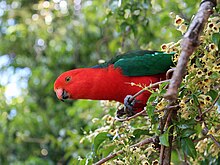Australian king parrot
| Australian king parrot | |
|---|---|
 |
|
| Male in south-east Queensland | |
| Scientific classification | |
| Kingdom: | Animalia |
| Phylum: | Chordata |
| Class: | Aves |
| Order: | Psittaciformes |
| Superfamily: | Psittacoidea |
| Family: | Psittaculidae |
| Subfamily: | Psittaculinae |
| Tribe: | Polytelini |
| Genus: | Alisterus |
| Species: | A. scapularis |
| Binomial name | |
|
Alisterus scapularis (Lichtenstein, 1818) |
|
 |
|
| Australian king parrot range (red: all-year resident) |
|
The Australian king parrot (Alisterus scapularis) is endemic to eastern Australia ranging from Cooktown in Queensland through to Port Campbell in Victoria. Found in humid and heavily forested upland regions of the eastern portion of the continent, including eucalyptus wooded areas in and directly adjacent to subtropical and temperate rainforest. They feed on fruits and seeds gathered from trees or on the ground.
The Australian king parrot was first described by the German naturalist Martin Lichtenstein in 1818. The species belongs to the genus Alisterus, whose three members are known as king parrots. The genus is sometimes sunk into the genus Aprosmictus.[citation needed]
Two subspecies are recognised, which are differentiated by size:
Adults of both sexes are about 43 cm (17 in) in length, including the long, broad tail. The adult male has a red head, breast, and lower undersides, with a blue band on the back of the neck between the red above and green on the back, the wings are green and each has a pale green shoulder band, the tail is green, and the rump is blue. The male has a reddish-orange upper mandible with a black tip, a black lower mandible with an orange base, and yellow irises. The plumage of the female is very different from the male having a green head and breast, a grey beak, and the pale shoulder band is small or absent. Juveniles of both sexes have brown irises and a yellowish beak, and otherwise resemble the female.
The two subspecies are A. s. minor, found at the northern limit of the species range and is similar in appearance to the nominate subspecies but smaller, typically about 5 cm (2 in) smaller in length.
On those rare individuals which have areas without melanin, feathers are orange to yellow. Such a bird can look startingly different from the more common scarlet and green variety.
Other variations include the Aprosmictus erythropterus or red-winged parrot, which has a bright green head, red wings, and a black back.
Australian king parrots range from north and central Queensland to southern Victoria. They are frequently seen in small groups with various species of rosella. Further from their normal eastern upland habitat, they are also found in Canberra during winter, the outer western suburbs and north shore of Sydney, and the Carnarvon Gorge in central Queensland.
...
Wikipedia

